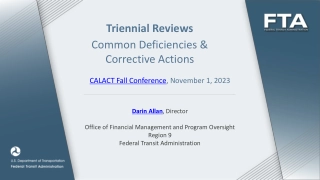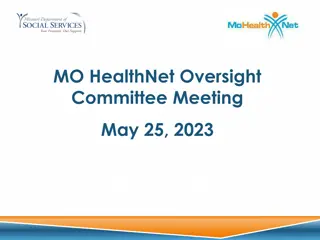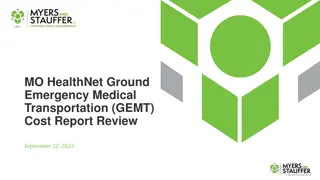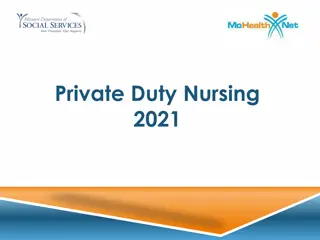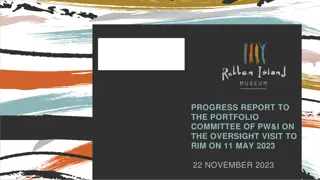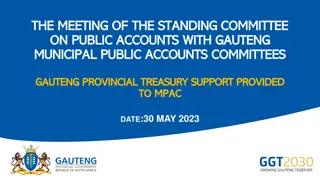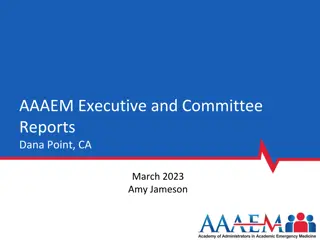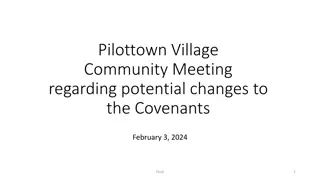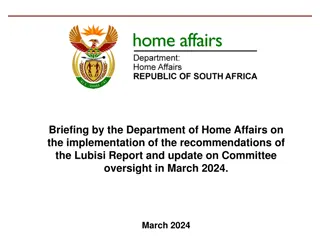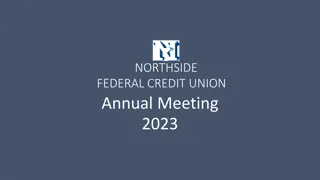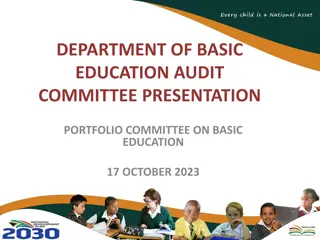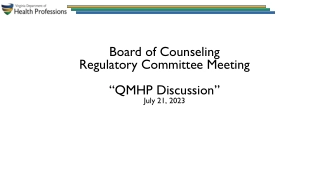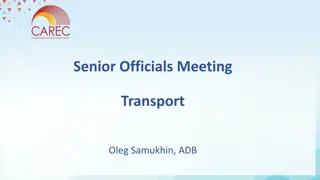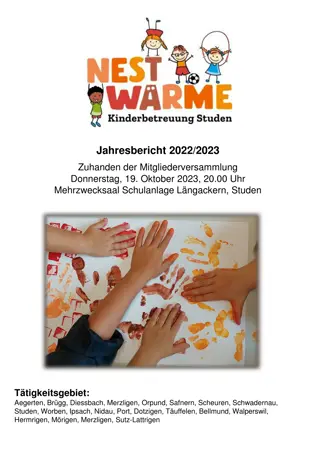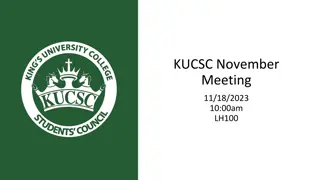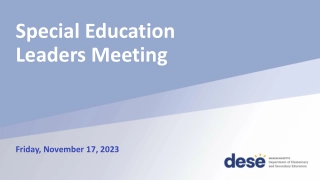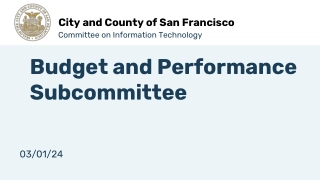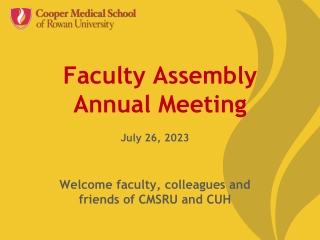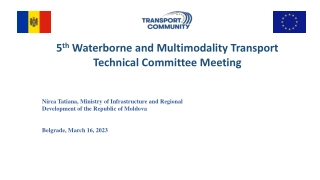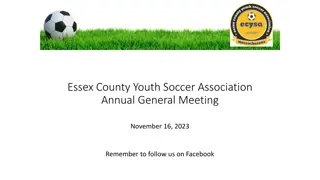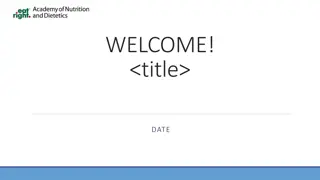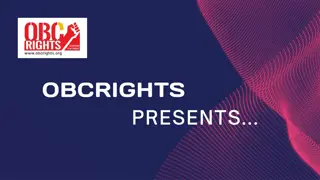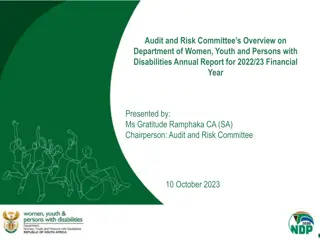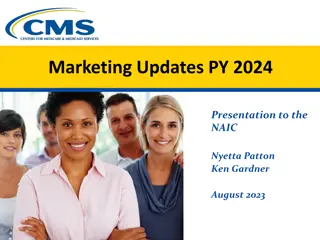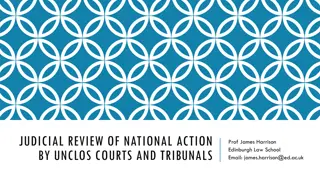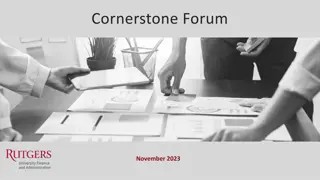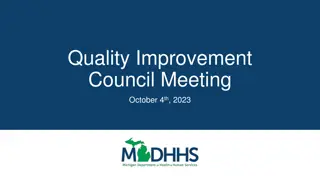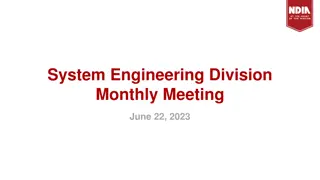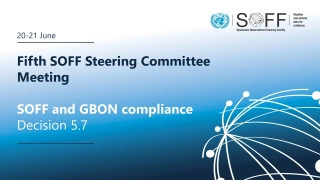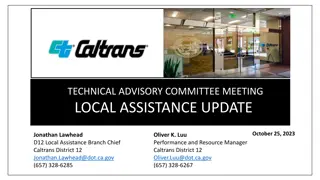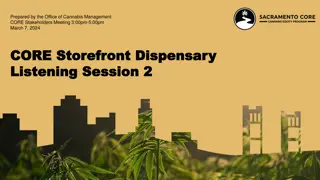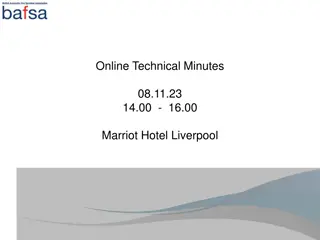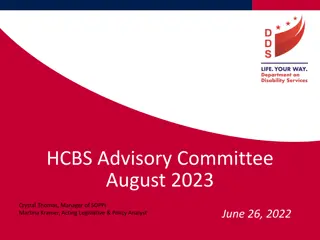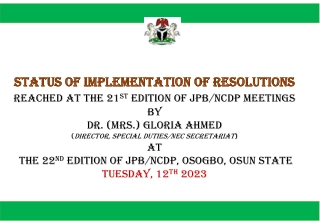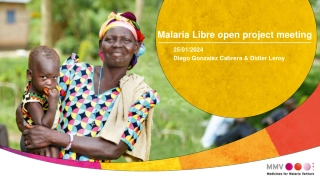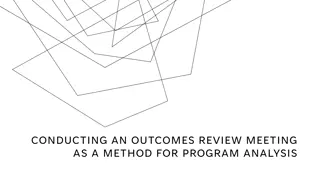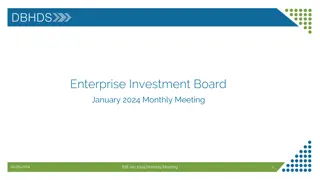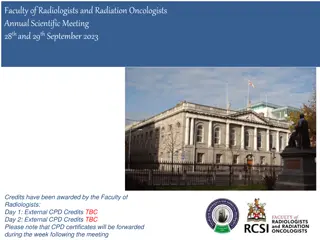MO HealthNet Oversight Committee Meeting. November 7, 2023
The Missouri HealthNet Oversight Committee Meeting on November 7, 2023, covered various updates and reports including Director's Update by Todd Richardson, Family Support Division Update by Kim Evans, and discussions on Managed Care, Pharmacy Clinical Updates, Budget, and Legislative Updates. The meeting aimed to empower Missourians for safe, healthy, and productive lives with a focus on continuous eligibility for children effective January 1, 2024.
MO HealthNet Oversight Committee Meeting. November 7, 2023
PowerPoint presentation about 'MO HealthNet Oversight Committee Meeting. November 7, 2023'. This presentation describes the topic on The Missouri HealthNet Oversight Committee Meeting on November 7, 2023, covered various updates and reports including Director's Update by Todd Richardson, Family Support Division Update by Kim Evans, and discussions on Managed Care, Pharmacy Clinical Updates, Budget, and Legislative Updates. The meeting aimed to empower Missourians for safe, healthy, and productive lives with a focus on continuous eligibility for children effective January 1, 2024.. Download this presentation absolutely free.
Presentation Transcript
MO HealthNet Oversight Committee Meeting November 7, 2023
Agenda November 7, 2023 Welcome/Introductions/Minutes Approval of February meeting minutes 1:00 1:15 Dr. NickPfannenstiel, Chairman 1:15 1:30 Director s Update Todd Richardson 1:30 1:45 Chief Operations Officer Update Jessie Dresner 1:45 2:15 Family Support Division Update Division Of Developmental Disabilities Update Chief Information Officer Update Kim Evans, FSD Director 2:15 2:30 Jessica Bax, DD Director 2:30 2:45 Michelle Hoeller 2:45 3:00 Managed Care Update Alex Daskalakis 3:00 3:15 Pharmacy Clinical Update Josh Moore 3:15 3:30 Budget Update Tony Brite 3:30-3:45 Legislative Update Ryan Conway 3:45-4:00 Public Comment Next Meeting February 15, 2024
DIRECTORS UPDATE TODD RICHARDSON
Chief Operating Officer Update Jessie Dresner
FAMILY SUPPORT DIVISION UPDATE KIM EVANS
Empower Missourians to live safe, healthy, and productive lives. November 7, 2023 6
P PHE Unwind April 1, 2023, Missouri started the unwind process Currently FSD is in the process of mailing annual renewals forms for reviews due in December and processing annual renewals for November Information on the unwind process https://mydss.mo.gov/renew New Annual Renewal Monthly Metrics published at https://dss.mo.gov/mis/clcounter/
P Continuous Eligibility for Children Effective January 1, 2024 Coverage re-determined every 12 months ( Annual Renewal) Termination of Eligibility When the child or child s representative requests voluntary closure When the agency determines eligibility was granted in error because of agency error or fraud The child is deceased Staff are working on policy and system changes
Unlocking the Potential of Value-Based Payments: The Missouri Value-Based Payment Journey
Agenda How Missouri Got Here The Incentives Metrics Challenges & Next Steps
VBP Initiatives Fiscal Year 2023 Modernizing Medicaid Long Term Care: Value Based Payment DMH - Division of Developmental Disabilities Establish Baseline Rates $375.1 million ($127.7M GR) to establish a baseline wage for Direct Support Professionals. Outcomes Based Payment $4.3M ($1.5M EFMAP) quarterly incentive payments based on implementation of evidence-based behavioral supports. (-) $14M ($4.8M GR) savings from expansion of remote services which provides clients with more independence starting July 1, 2022. $255K ($87K EFMAP) for incentives for providers utilizing location verified timekeeping through Electronic Visit Verification. Implement Baseline Value Based Payment Initiatives Workforce Recruitment and Retention $21.2M ($7.2M EFMAP) rate increase when a percentage of the provider workforce attains one of three certification levels. $250K ($85K EFMAP) incentive payment to providers who hire a DSP Apprentice talent pipeline. $98K ($49K EFMAP) to expand current capacity of DSP Apprenticeship Program. $294K ($147K EFMAP) to create DSP certification levels and associated training modules. $500K ($250K EFMAP) one-time to conduct an analysis of barriers preventing cross-sector career paths within various sectors of the healthcare industry. Data for Future VBP Outcomes Performance Benchmarking $1.5M ($501K EFMAP) incentive payment to providers who complete the National Core Indicators (NCI) survey which provides data on wages, turnover, and retention within the DSP workforce. $1.1M ($369K EFMAP) incentive payment to providers for each client screened for health risk and cost reduction using a health risk assessment tool. $184K ($63K EFMAP) rate increase for employment providers who provide data to the state for benchmarking. $9.9M Enhanced FMAP IT tools and features to support Value Based Payments including data analysis, population health management, stakeholder engagement, and plan development. Missouri Health Risk Screening tool module System interoperability, enable eLTSS data sharing, and connect to health information networks. Enhance DD case management system to support automated processing. IT Infrastructure Total $411.6M ($127.7M GR) 27% increase over FY22 $7M (3.5M Enhanced FMAP) for administrative costs and payments to Mercer for technical assistance and consultation for Medicaid related initiatives. Admin
The Big Picture Reward Those Who Facilitate Quality Outcomes Improve Individual Outcomes Great Public Stewards
The Big Picture: Drivers and Strategies Healthcare Access Quality and Intervention HRST Tiered Supports Electronic Health Records Skilled Workforce DSP Training Levels Registered Apprenticeship Relias Learning Mgmt System Accountability Organizational Efficiency Electronic Visit Verification (EVV) Alternative Payment Methods Stable & Accessible Workforce NCI State of the Workforce Survey Registered Apprenticeship Workforce Barrier Scan Efficiency ConneXion LEAP Grant Health IT Social and Community Inclusion Service Definitions Remote Supports Economic Stability Employment First Cash Flow Pay for Reporting Rate Standardization Performance Payments (VBP) Transparency Division Dashboards Provider Scorecard Environmental Accessibility Technology First Reward for Facilitating Quality Outcomes Improved Individual Outcomes Great Public Stewards
Value Based Payment: Overview In State Fiscal Year (SFY) 2023, Missouri s General Assembly approved $597M for Rate Standardization, Information Technology, and Value Based Payments. Leveraging the enhanced FMAP from ARPA 9817. Supported the launch of Missouri Division of Developmental Disabilities (DD) nine (9) value-based payment (VBP) incentives. https://dmh.mo.gov/media/pdf/vbp-incentive-table Missouri Legislature included funding for VBP for SFY 2024. All incentives are applicable to select home and community-based services (HCBS) in Missouri s DD 1915 (C) waiver. CMS waiver amendment approval was granted effective January 2023.
Guidehouse DMH DD has contracted with Guidehouse to assist with the VBP Program. This assistance includes, but not limited to: Oversee and implement REDCap design and updates; Complete initial REDCap record reviews; and Reviews in REDCap will indicate if it is a Contractor review. DMH DD completes a secondary review prior to final approval and payment. Review and respond to emails sent to the DMH DD VBP email address. Email responses will indicate if a member of the Guidehouse VBP Team is responding.
Value Based Payment: Data Entry All VBP reporting is completed in REDCap. REDCap is a secure, online data collection tool. Missouri has utilized REDCap for other reporting across various Departments. Each incentive requires a different level of reporting. Incentives are reported on a monthly, quarterly, semi- annually, and annual basis. All REDCap entries are verified against a secondary data source for validation and approval.
Electronic Visit Verification (EVV) Who: Any service providers of agency personal assistant services that successfully connect with the state EVV aggregator. Self- Directed Service Personal Assistant is not eligible. What: Payment of 1% over the Medicaid paid personal assistant claims for six-month period. When: Semi-annual reporting, every six months. Why: Electronic timekeeping, adds efficiency, provides quicker payments, allows for better coordination of care, easier scheduling, verification that care was received at the point of care, and minimizes billing errors. How: Successful submission of EVV records for at least 80% of personal assistant services claims and complete the corresponding REDCap form.
NCI Staff Stability Survey Who: Current DMH DD contracted 1915 (c) HCBS Waiver service providers of residential, in-home and non-residential services. What: Annual lump sum payment of $2,000 per qualifying provider. When: Annual reporting. Why: The Survey collects information on the DSP workforce, including information on staff wages, retention, and turnover. The Survey supports the DMH s policy and program development to enhance the retention efforts and training needs of the DSP workforce. How: Complete the Survey in the NCI system and corresponding REDCap form.
CDSP Registered Apprenticeship Who: Any Division of Developmental Disabilities HCBS waiver service provider who participates in the Direct Support Professional (DSP) Registered Apprenticeship Program. What: Two payments for each employee apprentice: $1,560 upon 50% completion of the program and $1,560 upon 100% completion of the Registered Apprenticeship Program. When: Quarterly reporting. Why: A talent acquisition pipeline with increased staff retention; employees gaining national best practice skills; mitigation of risk and improved individual outcomes. How: Qualified providers submit documentation through the US Department of Labor s RAPIDS database and corresponding REDCap Form. To be eligible for this incentive, the employee must be a new workforce member not previously employed by the provider within the 6 months prior to enrollment in the apprenticeship program.
HRST Rater Person Centered Thinking Training Who: Current DMH DD contracted residential service provider organization with designated MO HRST Residential Rater staff. What: A one-time payment of $840 for each waiver provider MO HRST Residential Rater completion of the Person-Centered Training during the identified timeframe. When: Quarterly reporting beginning SFY 2024 for waiver providers. The Division is submitting the incentive to CMS for approval in the TCM SPA Why: The training will support the HRST Rater with identification and implementation of person centered thinking strategies to enhance individualized person centered health risk support planning, improve health outcomes, and support individual waiver participant health and welfare. How: Training completed in IntellectAbility system and completion of corresponding REDCap form.
HRST Rater Advanced Fatal Five Plus Training Who: Current DMH DD contracted residential service provider organization with designated MO HRST Residential Rater staff. What: A one-time payment of $428 for each waiver provider MO HRST Residential Rater completion of the Advanced Fatal Five Plus Training during the identified timeframe. When: Quarterly reporting beginning SFY 2024 for waiver providers. The Division is submitting the incentive to CMS for approval in the TCM SPA. Why: The information will support the HRST Rater with identification of implementation strategies to mitigate risk, improve health outcomes and support individual waiver participant health and welfare. How: Training completed in IntellectAbility system and completion of corresponding REDCap form.
Employment Reporting Who: Any Division of Developmental Disabilities HCBS contracted employment services provider. What: Payment of $55 for each completed report. This payment is a data reporting payment for VBP benchmarking in future years. When: Quarterly reporting. Why: To incentivize providers to share data to be utilized for benchmarking performance to inform future development of value-based payments. How: Submission of defined data elements through a REDCap form.
Remote Supports Who: Any Individualized Supported Living and In-Home Respite service provider who has transitioned to remote supports resulting in an overall reduction in budget due to reduced staffing hours. What: Payment of 15% of the savings realized due to the reduction of individualized supported living or respite paid supports with the implementation of remote supports. When: Semi-annual reporting, every six months. Why: Increased individual independence and autonomy, reduction in stress level of overall DSP workforce, and savings to State. How: The savings is calculated monthly based on cost difference with implementation of Remote Supports as verified through CIMOR and the corresponding REDCap form.
Example of Remote Supports Hours Hourly Rate Monthly Rate 730.00 $19.30 $30.00 486.67 $30.00 240.00 $7.04 ISL Budget prior to RS ISL Budget prior to RS* 730.00 ISL budget with RS RS Response Center RS Technology Total Savings State Share of Savings VBP 15% VBP 6 month payment $14,089.00 $21,900.00 $14,600.10 $1,689.60 $750.00 $4,860.30 $1,652.02 $247.80 $1,486.81 *At current hourly rate
Tiered Supports Who: Any service provider agency currently providing ISL service. What: Two Payments (pay for reporting & implementation level): Monthly payment for sharing data elements identified in the provider contract for each monthly period. Quarterly payment based on assessment of implementation systems each quarterly period. When: Monthly, quarterly, and yearly reporting. Why: To incentivize providers to develop and maintain universal systems of support which result in higher quality of life, fewer risk outcomes, and reduced staff turnover. How: Submission of data through REDCap using standard Levels of Implementation by Benchmark for quarterly payment.
Tiered Supports Tool to Assess Implementation Level
DSP Training Levels Who: Any waiver service non-licensed professional staff delivering contracted HCB services. Services include: Personal Assistant, Personal Assistant -Medical Exception, Day Habilitation, Day Habilitation -Behavioral Exception, Day Habilitation -Medical Exception, Community Networking, Individualized Skill Development, Career Planning, Prevocational, Job Development, Supported Employment, In-Home Respite Day, In-Home Respite Individual, In-Home Respite Group, Out-of-Home Respite Day, Temporary Residential, Residential Group Homes, ISL, Shared Living, and Intensive Therapeutic Residential Habilitation. What: Payment of 1%, 2%, or 3% over the Medicaid paid applicable service claims based on percent of DSP workforce training completion and tenure. When: Semi-annual reporting, every six-months. Why: Increased staff retention; employees gain national best practice skills; mitigation of risk and improved individual outcomes. How: Access Relias to obtain DSP certification level learning tracks and completion of corresponding REDCap form.
DSP Training Levels Impact VBP DSP Training Incentive VBP DSP Training Incentive The [wage] increase has made it more convenient for my household and medical expenses. One thing I learned form the [Relias] training is how to engage more with the clients and how to care for the clients in the best ways possible. I also learned what to do if there are any emergencies or fire situations in homes. I feel the [DSP Learning] pathway to has made a difference in my work by me taking all of the knowledge that I ve learned and using it on a daily basis at work. I am grateful and happy for the training experience. The [wage] increase has put me in a position that I am now able to save money after my bills are paid. If I need new tires or a repair, I m able to afford it. I m no longer living paycheck to paycheck. The training taught me so much about how to care for our clients from food texture to emergencies to the clients rights. It has helped me to do a better job at caring for our clients in a more confident manner. I am so very grateful to be a part of [provider] but mostly I m glad the clients have [provider].
Value Based Payment: Metrics Participating VBP Providers by Incentive Type 646 Eligible Providers 130 Unduplicated Providers Participating (have at least 1 REDCap Entry) 20% of eligible providers have participated ** Goal is 25-35% Participation** Tiered Supports - Pay for Reporting 13% Tiered Supports - Level of Implementation Employment Pay for Reporting 31% 13% Remote Supports Direct Support Professional Training Levels 9% Electronic Visit Verification 105 Unduplicated Providers Who Have Received a VBP Payment To Date 16% of eligible providers have received a payment 4% 12% Registered Apprenticeship 7% 1 10% Health Risk Screening Tool National Core Indicators Staff Stability Survey Includes data from SFY23 Quarter 1, 2, & 3
Value Based Payment: Metrics Breakdown of Payments Made To Date by Incentive Type Tiered Supports - Pay for Reporting 12% Tiered Supports - Level of Implementation 12% National Core Indicators Staff Stability Survey 47% Employment Pay for Reporting 12% Remote Supports 4% Direct Support Professional Training Levels 3% Health Risk Screening Tool 6% Registered Apprenticeship 0% Electronic Visit Verification 4% Includes data from SFY23 Quarter 1, 2, & 3
Value Based Payment Challenges Next Steps Data Entry New data entry system for Providers Limitations of System Hesitancy of Provider Buy-In Return of Signed Contract Amendments Evaluation of provider experience to inform future decisions on data entry, VBP targets, and payment terms. Refinement of data entry to create a more user-friendly process. Development of new incentives. Targeted provider outreach to increase participation.
Contact Information Questions? Email dmhdd.vbp@dmh.mo.gov
Missouri Medicaid Enterprise (MME) Modernization Update Medicaid Enterprise Data Warehouse complete Health Information Network Services complete Interoperability and Patient Access Rule complete Program Integrity - complete Electronic Visit Verification (EVV) complete Beneficiary Support: Participant Enrollment/Premium Collections currently implementing Managed Care Contract Management RFP in development for the overall management Pharmacy and Drug Rebate developing the RFP Service Authorization and Professional Review Services developing the RFP Provider Enrollment RFP in place through NASPO. Participating addendum planned soon Core claims Processing System including financial transactions RFP in place through NASPO ValuePoint and implementation TBD 44
What is an ILOS? In Lieu of Services (ILOS) is a mechanism through which Managed Care Organizations (MCOs) may offer health services that are appropriate substitutes for existing covered services. ILOS are sometimes provided in alternative settings, by nontraditional providers, and are developed with the intention of promoting better health outcomes for members. 46
ILOS Requirements To be approved, ILOS must be determined by the state to be medically appropriate and cost-effective substitutes for Missouri Medicaid covered services. According to 42 CFR 438.3(e)(2) the state must ensure that: The alternative service or setting is a medically appropriate and cost effective substitute for the covered service or setting under the State plan; The member is not required by the MCO to use the alternative service or setting; The approved ILOS are included in the MCO s member handbook; and The utilization and actual cost of ILOS are taken into account in developing the medical component of the MCO s capitation rates. 47
ILOS and Social Determinants of Health (SDOH) 48
Benefits of ILOS Allows MCOs to offer services in innovative, community centered ways that meet members where they are, while addressing the social determinants of health and equity for their members. It provides MCOs with increased flexibility to offer key covered services in alternate settings with the goal of improving access to services, enhancing care coordination for members, and reducing hospital, emergency department, and nursing facility care. 49


